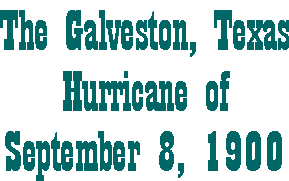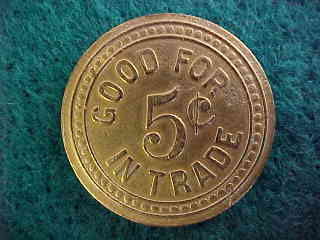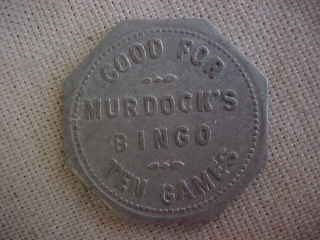

PAGE 24

By Jerry Adams copyright ã 1998, all rights reserved
THE TOKENS:
TREMONT HOTEL / CIGAR STAND/ GALVESTON / TEXASGOOD FOR / 5 ¢ / IN TRADE
Brass-round-21millimeters ( listed in The Trade Tokens of Texas, April 1973 TAMS, by Fowler, Roberts & Strough, estimated value $20, est. date 1900)


GOOD FOR / MURDOCK’S / BINGO / TEN GAMES
Same as obverse
Aluminum-octagonal-25 millimeters (Galveston, Texas; listed in The Trade Tokens of Texas as above, est. value $7, est. date 1900-1940)

THE CALM BEFORE THE STORM
In the age before weather satellites, television weathermen, and CNN, Galveston, Texas had a population of 37,789 persons in 1900. The city sits on Galveston Island, just off the Texas coast, connected by a causeway. The city occupied the eastern end of the island in 1900, and was built right on the sand, which rose only 8.7 feet above sea level at the highest point, and the average elevation above sea level was 4.5 feet. It was a city of splendid homes, large warehouses of goods, banks, churches, hotels, and amusements. Many people came from inland to the beaches to "bath" in the salty surf. The Victorian women were delicate creatures, who wore black bathing suits to "bath" in the surf, and men wore suits that covered their lower and upper body. Modesty was rampant.
Galveston was at the time, a leading seaport, due in part to the high output of cotton farming in Texas. Galveston had also served as an entry point for thousands of immigrants from European countries for decades. The island city was smug with invincibility, born of naivete.
THE STORM CLOUDS BUILDA tropical storm arose out of the warm ocean waters about August 27th, in the Atlantic Ocean, almost 4,000 miles away, near Cape Verde Islands. The storm wandered, gaining strength from the heat and moisture, passing just south of Puerto Rico on August 31. On September 2nd, it raked the island of Hispanola, and crossed Cuba on September 3rd and 4th , touching the Florida Keys on September 5th. By now, the un-named storm was packing winds later estimated at 120 mph, entered the warm waters of the Gulf of Mexico, whose warm waters feed hurricanes to brute size. On Saturday, September the 8th, the storm struck an unprepared Galveston Island, and changed history.
THE WORST NATURAL DISASTER IN AMERICAN HISTORY
Most people do not realize that the Galveston hurricane of 1900 was the worst natural disaster in American history, measured in human lives. The storm killed at least 6,000 people, and perhaps as many as 8,000. The loses were so horrific, and the recovery efforts so hampered, that accurate estimates were impossible. The wall of water that smashed the city, left little unscathed, and the pull of the water as it receded back into the Gulf was even worse. Cemeteries had their graves washed clean, horses, dogs, humans, chickens, marines creatures and a wreckage of twisted wooden structures, bricks, sand and debris all mingled together in a great salty mess. Great numbers of naked bodies lay across the city, wherever the vagaries of the tempest dumped them. Rescue boats spotted dozens of corpses floating in the bay west of the island.
The Pagoda Bathhouse, was a large structure on piers which jutting out into the gulf, it withstood the winds and tides until about 11 AM on September 8th, when it suddenly dropped into the ocean. More wooden pier supported structures, Murdock’s Bathhouse and the Olympia pleasure resort also fell into the pounding surf. The Tremont Hotel was thought to be the highest point on the island, and by 9:30 AM, the water in the lobby was over the front desk and covered the pages of the register. The Tremont Hotel’s enginehouse caved in from a falling smokestack. A newly completed 3 story building called the Politz, collapsed and the Ritter Building followed suit. The Sealy Hospital was awash in the tempest and most of the patients drown.
6,000 PLUS Dead
Sunday the 9th of September saw the day break sunny and hot, and the thought of 6,000 plus corpses decomposing in the heat, made the survivors decide to haul the corpses to sea on barges. The tragic cargo was carted to the 12th street wharf, loaded on barges and hauled out to sea. Most were never identified, but the fact that looters were scavaging the bodies, cutting off fingers for the gold rings and ears for ear rings. One looter was found to have 23 gold rings with fingers still attached, stuffed into his pocket. Some 30 odd looters were arrested and most were executed without fanfare.
Post Hurricane: THE SEAWALL
After the hurricane, Galveston launched upon a massive construction project which would build a seawall along the beach, and once the seawall was complete, raise all the remaining structures on jacks, and fill in sand and fill beneath them by means of dredges.
The original designer of the seawall was General H. M. Roberts, the author of Robert’s Rules of Order. The first pile was driven October 27, 1902, and was built in segments, completed in 1962. The wall is 10.4 miles long.
This project took years, and the seawall averages 12 feet high, concrete construction, with large granite rip rap stones at the base. As money became available, the seawall was extended along the beach. Today, the seawall is still there, and is a familiar sight to tourists from across the country. The memory of the horrible tempest is recorded in words and photographs to remind the visitors couched in the refrigerated air comfort of their hotel suites, that man is not always dominant over the sea.
In 1998, the sidewalk atop of the Galveston seawall is the home to bikini clad roller-bladers, a vision which would surely have shocked the islands inhabitants in September of 1900.
References: Texas Public Buildings of the19th Century, by Willard B. Robinson; Atwood-Coffee Catalogue of Transportation Tokens, 4th edition, by John M. Coffee, Jr.; The Story of The Galveston Hurricane, by Nathan C. Green, 1900.
on to page 25 of our token web pages...
revised : 5 feb 2000